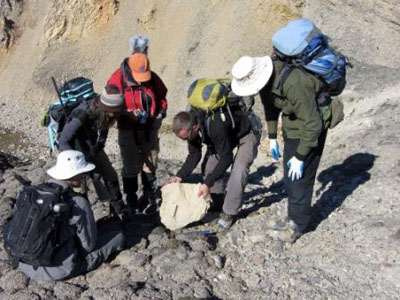Canadian astronaut prepares for mission in the High Arctic
“This analogue mission is very much what a real mission will be like.”

The view down Shatter Cone Canyon, with a crew member holding a tripod to take a panoramic photograph. (PHOTO COURTESY CPSX)

Right now, Canadian astronaut Jeremy Hansen is studying this crater, produced by a meteorite crash, near Collinson Inlet on Victoria Island. (PHOTO COURTESY CPSX)

The crew with a rock displaying shatter cones at varying orientations. (PHOTO COURTESY UWO CENTRE FOR PLANETARY SCIENCE AND EXPLORATION)
It turns out the remote Arctic is a good place to learn about the moon.
Canadian Space Agency astronaut Jeremy Hansen is preparing for international missions to the moon or Mars by studying a suspected meteorite impact site 26 kilometres wide near Collinson Inlet on the Northwest Territories side of Victoria Island, a two-hour flight from Cambridge Bay.
The 10-day trip started July 1, lead by Gordon Osinski of the University of Western Ontario, acting director of the UWO’s Centre for Planetary Science and Exploration, and a team of four researchers.
The research is aimed at helping inform astronauts about what they may find during future space exploration.
“We’re going to want to know what the structures are and what the resources may be,” Hansen said in an interview from Collinson Inlet.
Either way, the geology training will benefit Hansen, because it mimics what he might experience on a trip to the moon or to Mars.
“I think we’ll likely end up going back to the moon, while we make preparations to go to Mars,” Hansen said.
Team members also have to rely on each other and deal with Mother Nature, Hansen said, while approaching the work as geologists.
The Canadian Arctic could play a significant role in future space missions, he said.
“We largely take the Arctic for granted, but it really is an important part of Canada,” he said, adding Nunavut youth need to start looking at careers in the field — because voyages to Mars may be happening in their lifetimes.
The site on Collinson Inlet is home to a large canyon, and the team has two ATVs to use during their stay — so they will visit only a small portion of the crater.
“It’s a lot of ground to cover,” Hansen said.
The next step is to determine the size and age of the meteorite crater, which is the most common type of geological feature on the moon.
Hansen’s hands-on training is similar to what U.S. astronauts Charles Duke and John Young received in Sudbury, Ont., preparing in 1971 for the Apollo 16 mission, when they spent 71 hours on the surface of the moon.
Meteorite impacts, if big enough, can create enough heat and rock movement to create rich deposits of iron, uranium, diamonds and other valuable materials.
The Sudbury mining district was formed nearly two billion years ago when an asteroid hit a 10-kilometre area, generating ore in the process that is now worth more than $10 billion.
Evidence of a great collision can come in the form of shatter cones — the only characteristic evidence of shock, or, proof of an impact event.
“Found our first shatter cone! Strong supporting evidence that we are in a meteorite impact crater. Some happy Geologists!” Hansen said on Twitter.
The entire team was excited about it. “Amongst a lot of great folds and fascinating strata, we found the absolute motherload of shatter cones!”
This means the the trip has been a success.
The team spent the first night unloading gear and watching their pilots head for Resolute, their first point of contact in an emergency, leaving the crew with “equipment, each other, and nothing else but empty, silent tundra for hundreds of kilometers in every direction,” they wrote on their blog.
The camp is set up with a dome tent for kitchen and science work and personal sleeping tents, an outhouse tent, two ATVs, a gasoline generator, two solar PV-arrays or panels, a satellite phone and modem, and a rifle to ward off bears.
The researchers are using standard geology tools such as hammers and compasses, but also light detection and ranging technology and a 3D stereo camera imaging system.
“This analogue mission is very much what a real mission will be like. None of the team has ever been to this site and very little is known about this region of the Arctic,” head geologist Osinski said in a news release.
To date, Osinski has gone on 13 Arctic field expeditions.
Hansen is a former Canadian Armed Forces fighter pilot and graduated from NASA astronaut candidate training in 2011.
He’s been assigned as crew support astronaut for the 34th expedition to the International Space Station, set to launch in November 2012.





(0) Comments